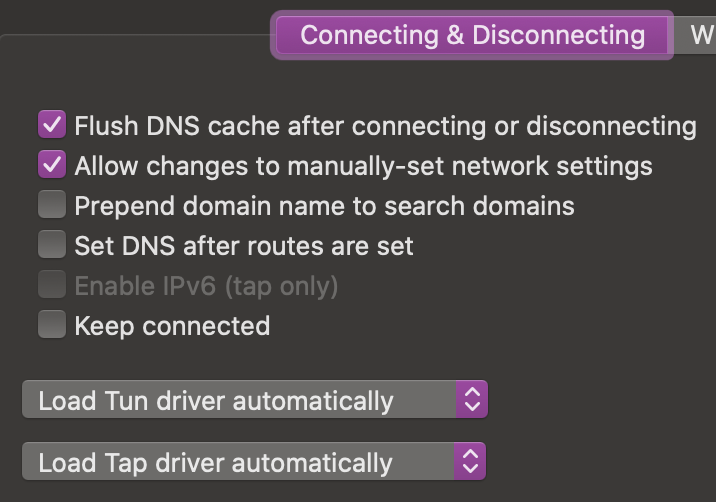What you need:¶
OpenVPN
client certificate <username>.crt
client private key: <username>.key
server certificate: ca.crt

OpenVPN is a full-featured, open-source Secure Socket Layer (SSL) VPN solution that accommodates a wide range of configurations. In this tutorial, you will set up an OpenVPN server on an Ubuntu 18.04 server and then configure access to it from Windows. OpenVPN + Tunnelblick XOR Patch. The XOR patch for OpenVPN comes to us courtesy of the Tunnelblick team.They state that “the patch is attractive because it is so easy to implement: simply apply the patch to both the OpenVPN server and the OpenVPN client and add a single, identical option to the configuration files for each.”.
Settings:¶
server: vpn.osuosl.org:1194
type: Certificate (TLS)
protocol: UDP
device type: TUN
Network Manager (Linux)¶
Packages:¶
Debian/Ubuntu: sudo aptitude install openvpn network-manager-openvpn
Procedure:¶
Copy your key, certificate, and server certificate to a secure location ofyour choice such as ~/openvpn/. Set paranoid permissions (-r-x—— orsimilar).
Install Network Manager (installed by default in many Linux distributions)
Install the Network Manager OpenVPN package
Open Network Manager
Add a new VPN connection:
Connection name: <witty name>
Gateway: vpn.osuosl.org
Type: Certificates (TLS)
User Certificate: <username>.crt
CA Certificate: ca.crt
Private Key: <username>.key
Private Key Password: <password> (if applicable)
IPv4 Settings->Routes…->Use this connection only for resources on itsnetwork: ✔ (if unchecked, all network traffic is routed through the VPN)
Apply
Click on the Network Manager status bar icon and select VPNConnections-><witty name>
Wait until connection is established
Check connection:
ifconfig -a: IP address should be in the 10.2.*.* range.
ping 10.2.0.1: The router should respond
Trouble shooting¶
Shotgun style - try again, reboot, disable network devices, do the chickendance. If all else fails, try the command line version. If that works, try thisagain, maybe it just didn’t like you the first time.

OpenVPN command-line client¶
Packages:¶
Debian/Ubuntu: sudo aptitude install openvpn
Gentoo: sudo emerge openvpn. For detailed instructions, including kernelconfiguration see http://en.gentoo-wiki.com/wiki/OpenVPN.
Procedure:¶
Tunnelblick Ubuntu Latest
Copy your key, certificate, and server certificate to a secure location ofyour choice such as /etc/openvpn/. Set paranoid permissions (-r-x—— orsimilar).
Create a configuration file in a location of your choice such as/etc/openvpn/openvpn.conf. Here is an example configuration file:
Run OpenVPN: openvpn /etc/openvpn/openvpn.conf
Check connection:
ifconfig -a: IP address should be in the 10.*.*.* range.
ping 10.0.0.1: The router should respond
Tunnelblick (OS X)¶
Tunnelblick is a free, open source gui for OpenVPN on OS X that allows for easycontrol of the OpenVPN client.
Troubleshooting¶
The version of OpenVPN we are running is incompatible with OpenVPN client v2.4+ on OS X.If you are running OS X, please use OpenVPN v2.3 to connect to the VPN.
Disabling LZO compression may help on older OpenVPN instances.
In addition, the version of OpenVPN we are running is incompatible with TLSv1.2, so if you are running into issues(such as on Debian 10), please do the following in /etc/ssl/openssl.cnf:
We plan to resolve this issue soon.
Installation¶
Download and install Tunnelblick from the project’s downloads page.
Alternatively install the package using the Homebrew:
Configuration¶
Download this
Tunnelblickprofile.Replace the contents of
osuosl.tblk/USER.crtandosuosl.tblk/USER.keywith your personalcrtandkey.Double click the
osuosl.tblkfile to install the profile in Tunnelblick.Connect to the
osuoslprofile in Tunnelblick.
Note
Tunnelblick Ubuntu Game
You may need to check TunnelallIPv4 under the advanced settings forthe osuosl profile.
